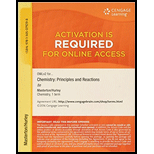
Concept explainers
A solution contains both iron(II) and iron(III) ions. A sample Of the solution is titrated with 35.0 ml, of M
Interpretation:
The concentration of
Concept introduction:
Number of moles is equal to the ratio of given mass to the molar mass.
The mathematical expression is given by:
Number of moles =
Molarity is defined as the ratio of number of moles of solute to the volume of the solution in liters.
The mathematical expression is given by:
Molarity =
A solution of salt of metal when reacts with other solution to give products, the formula which is used to find the volume of either solution is given by:
Where, M1 and M2 are molarity of the solution
V1 and V2 are volume of the solution
Answer to Problem 74QAP
Concentration of
Concentration of
Explanation of Solution
Given information:
Volume of sample = 50.0 mL
Volume of
Molarity of
The resulting solution titrated with:
Volume of
Molarity of
The given reaction is:
Divide the above redox reaction into two half reactions that is oxidation half reaction and reduction half reaction.
Oxidation Half reaction:
Reduction half reaction:
Assign oxidation states to each element in the above reactions.
Oxidation Half reaction:
Reduction half reaction:
Balance the elements except oxygen.
Oxidation Half reaction:
Reduction half reaction:
Now, add number of electrons (required) to that side of reaction where reduction occurs.
Oxidation Half reaction:
Reduction half reaction:
Balance the charge by adding
Oxidation Half reaction:
Reduction half reaction:
Balance the hydrogen and oxygen atoms by adding water molecules.
Oxidation Half reaction:
Reduction half reaction:
Multiply the oxidation half reaction with 5 to balance the number of electrons in both reactions.
Oxidation Half reaction:
Reduction half reaction:
Now, add both reactions.
Now,
Molarity =
Convert the volume in mL to L.
Since, 1 L = 1000 mL
Thus, volume in L =
Number of moles of
Number of moles = 0.0280 M× 0.035 L =
According to the reaction, the ratio between
Thus, number of moles of
When the resulting solution titrated again:
Convert the volume in mL to L.
Since, 1 L = 1000 mL
Thus, volume in L =
Number of moles of
According to the reaction, the ratio between
Thus, number of moles of
Number of moles of
Concentration of
Convert the volume in mL to L.
Since, 1 L = 1000 mL
Thus, volume in L =
Concentration of
Concentration of
Concentration of
Concentration of
Want to see more full solutions like this?
Chapter 4 Solutions
CHEMISTRY:PRIN.+REACTIONS-OWLV2 ACCESS
- At an electrified interface according to the Gouy-Chapman model, what types of interactions do NOT occur between the ions and the solvent according to this theory?arrow_forwardPlease predict the products for each of the following reactions. Clearly show the regiochemistry (Markovnikov vs anti-Markovnikov) and stereochemistry (syn- vs anti- or both). If a mixture of enantiomers is formed, please draw all the enantiomers. Hint: In this case you must choose the best answer to demonstrate the stereochemistry of H2 addition. 1.03 2. (CH3)2S BIZ CH₂OH 2. DMS KMnO4, NaOH ΖΗ Pd or Pt (catalyst) HBr 20 1 HBr ROOR (peroxide) HO H-SO HC 12 11 10 BH, THE 2. H2O2, NaOH Brz cold HI 19 18 17 16 MCPBA 15 14 13 A Br H₂O BH3⚫THF Brz EtOH Pd or Ni (catalyst) D₂ (deuterium) 1. Os04 2. H2O2 CH3CO3H (peroxyacid) 1. MCPBA 2. H₂O* H B + H H H "H C H H Darrow_forwardExplain how Beer’s Law can be used to determine the concentration in a selected food sample. Provide examples.arrow_forward
- Explain the importance of having a sampling plan with respect to food analysis. Explain the importance of having a sampling plan with respect to food analysis. Provide examples.arrow_forwardPlease predict the products for each of the following reactions. Clearly show the regiochemistry (Markovnikov vs anti-Markovnikov) and stereochemistry (syn- vs anti- or both). If a mixture of enantiomers is formed, please draw all the enantiomers. cold KMnO4, NaOH 2. DMS 1. 03 CH3OH Br2 1. 03 2. (CH3)2S H₂ Pd or Pt (catalyst) HBr 18 19 20 1 HBr ROOR (peroxide) H₂O H₂SO4 HCI HI 17 16 6 15 MCPBA 1. BH3 THF 2. H₂O2, NaOH 1. OsO4 2. H₂O₂ 110 CH3CO₂H (peroxyacid) 1. MCPBA 2. H₂O* Br2 H₂O BH3 THF B12 EtOH Pd or Ni (catalyst) D₂ (deuterium) Bra A B C D H OH H OH OH H OH α α α OH H OH OH фон d H "Harrow_forwardBriefly indicate the models that describe the structure of the interface: Helmholtz-Perrin, Gouy-Chapman, Stern and Grahame models.arrow_forward
 Chemistry: The Molecular ScienceChemistryISBN:9781285199047Author:John W. Moore, Conrad L. StanitskiPublisher:Cengage Learning
Chemistry: The Molecular ScienceChemistryISBN:9781285199047Author:John W. Moore, Conrad L. StanitskiPublisher:Cengage Learning ChemistryChemistryISBN:9781305957404Author:Steven S. Zumdahl, Susan A. Zumdahl, Donald J. DeCostePublisher:Cengage Learning
ChemistryChemistryISBN:9781305957404Author:Steven S. Zumdahl, Susan A. Zumdahl, Donald J. DeCostePublisher:Cengage Learning Chemistry & Chemical ReactivityChemistryISBN:9781133949640Author:John C. Kotz, Paul M. Treichel, John Townsend, David TreichelPublisher:Cengage Learning
Chemistry & Chemical ReactivityChemistryISBN:9781133949640Author:John C. Kotz, Paul M. Treichel, John Townsend, David TreichelPublisher:Cengage Learning Chemistry & Chemical ReactivityChemistryISBN:9781337399074Author:John C. Kotz, Paul M. Treichel, John Townsend, David TreichelPublisher:Cengage Learning
Chemistry & Chemical ReactivityChemistryISBN:9781337399074Author:John C. Kotz, Paul M. Treichel, John Townsend, David TreichelPublisher:Cengage Learning Chemistry: Principles and PracticeChemistryISBN:9780534420123Author:Daniel L. Reger, Scott R. Goode, David W. Ball, Edward MercerPublisher:Cengage Learning
Chemistry: Principles and PracticeChemistryISBN:9780534420123Author:Daniel L. Reger, Scott R. Goode, David W. Ball, Edward MercerPublisher:Cengage Learning General Chemistry - Standalone book (MindTap Cour...ChemistryISBN:9781305580343Author:Steven D. Gammon, Ebbing, Darrell Ebbing, Steven D., Darrell; Gammon, Darrell Ebbing; Steven D. Gammon, Darrell D.; Gammon, Ebbing; Steven D. Gammon; DarrellPublisher:Cengage Learning
General Chemistry - Standalone book (MindTap Cour...ChemistryISBN:9781305580343Author:Steven D. Gammon, Ebbing, Darrell Ebbing, Steven D., Darrell; Gammon, Darrell Ebbing; Steven D. Gammon, Darrell D.; Gammon, Ebbing; Steven D. Gammon; DarrellPublisher:Cengage Learning





